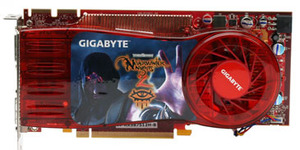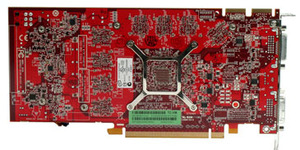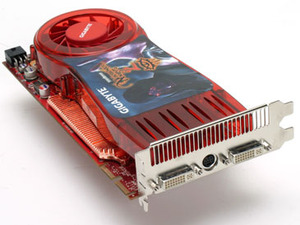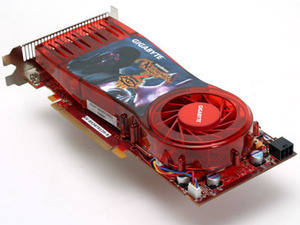Radeon HD 3870 card design
Core Clock: 775MHzMemory Clock: 2.25GHz (effective)
In the run up to the launch, both Gigabyte and Sapphire sent us Radeon HD 3870 hardware – both cards are largely the same apart from the artwork on the card, and of course their respective bundles. The Gigabyte card we were sent was an early sample that came in a white box without a bundle, while Sapphire’s card was a fully boxed retail sample – we’ll be reviewing that separately in due course.
Additionally, we also received a couple of Radeon HD 3850 cards too – one reference card from AMD and another from PowerColor. We will be looking at the Radeon HD 3850 separately in the near future as the focus for the time being is the Radeon HD 3870.
The Radeon HD 3870 employs a dual-slot cooling solution which AMD rates at 34dBA. The design is similar to the reference cooler on the Radeon X1950 XTX – a cooler that we really liked, and I have to say that this one is every bit as good, if not better. It’s also much better than the one on the Radeon HD 2900 XT, as this cooler doesn’t spin up during gaming like the 2900 XT’s did.
In fact, the cooling solution remained quiet during all of our testing – even with a pair of the cards running side by side in CrossFire. I guess that’s not really down to the Radeon HD 2900 XT’s cooling solution though – it’s more down to the fact that the Radeon HD 3870’s GPU is an efficient one, while the Radeon HD 2900 XT’s was quite the opposite.
I’m sure with a more efficient GPU, the Radeon HD 2900 XT would be as quiet as this card is, because it was fairly quiet when it wasn’t under load. Then again, it would no longer be a 2900 XT.
The Radeon HD 3870’s PCB is around 228mm long, which is a few centimetres shorter than the Radeon HD 2900 XT board. Most of the saved space is because of RV670’s reduced power requirements and they’re quite visible if you look at the card itself. Because of the more efficient GPU, AMD quotes the card’s worst-case thermal design power as 105W. One of the items you might have seen on the card’s feature list is PCI-Express 2.0 support. However, like the GeForce 8800 GT, it doesn’t support the increased power capabilities and instead draws just 75W through the PCI-Express interconnect.
This is in order to maintain backwards compatibility with existing PCI-Express 1.1 motherboards and, as a result, the card needs a single 6-pin PCI-Express power connector in order to meet its power requirements. Considering the fact that R600 had both 6-pin and 8-pin power connectors for correct operation (you could use two 6-pin connectors if you weren’t overclocking), this is pretty amazing for a GPU which AMD says is faster than the one it's replacing.
There are eight 64MB high-speed GDDR4 memory chips which are rated to 2.4GHz (effective) – this makes a total of 512MB on the reference card. AMD has said that if partners see the benefit, they can opt for different memory capacities which means that we could see a Radeon HD 3870 with 1024MB of memory at some point.
Getting back to the reference card, the memory is clocked to 2.25GHz (effective) which should mean that there is some overclocking headroom in the memory. The core, on the other hand, is clocked at 775MHz which is 33MHz higher than the Radeon HD 2900 XT’s stock core frequency. We’ve already got one pre-overclocked Radeon HD 3870 in the office, which we’ll be looking at very shortly – this would suggest that there should be some overclocking headroom in the core, too.
Before we get onto that though, I think it’s about time we dive down into the architecture...

MSI MPG Velox 100R Chassis Review
October 14 2021 | 15:04















Want to comment? Please log in.